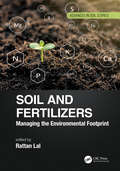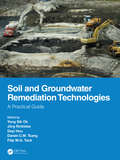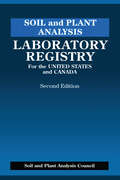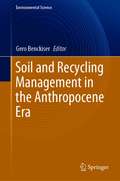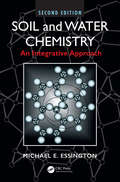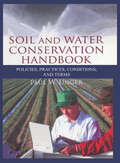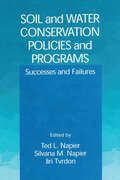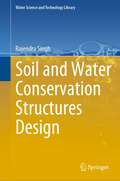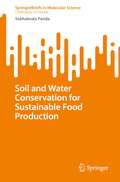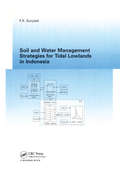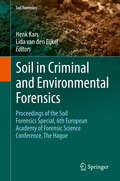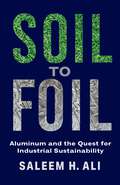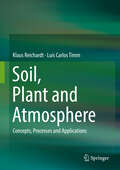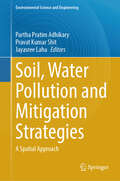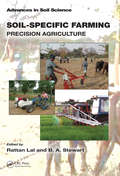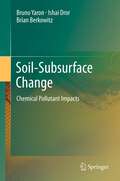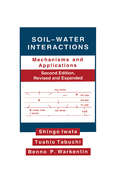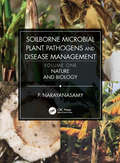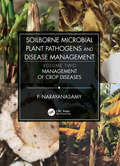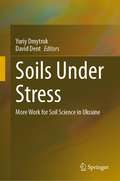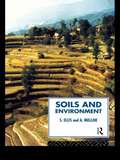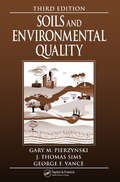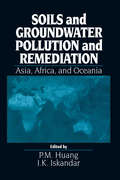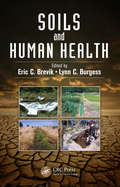- Table View
- List View
Soil and Fertilizers: Managing the Environmental Footprint (Advances in Soil Science)
by Rattan LalSoil and Fertilizers: Managing the Environmental Footprint presents strategies to improve soil health by reducing the rate of fertilizer input while maintaining high agronomic yields. It is estimated that fertilizer use supported nearly half of global births in 2008. In a context of potential food insecurity exacerbated by population growth and climate change, the importance of fertilizers in sustaining the agronomic production is clear. However, excessive use of chemical fertilizers poses serious risks both to the environment and to human health. Highlighting a tenfold increase in global fertilizer consumption between 2002 and 2016, the book explains the effects on the quality of soil, water, air and biota from overuse of chemical fertilizers. Written by an interdisciplinary author team, this book presents methods for enhancing the efficiency of fertilizer use and outlines agricultural practices that can reduce the environmental footprint. Features: Includes a thorough literature review on the agronomic and environmental impact of fertilizer, from degradation of ecosystems to the eutrophication of drinking water Devotes specific chapters to enhancing the use efficiency and effectiveness of the fertilizers through improved formulations, time and mode of application, and the use of precision farming technology Reveals geographic variation in fertilizer consumption volume by presenting case studies for specific countries and regions, including India and Africa Discusses the pros and cons of organic vs. chemical fertilizers, innovative technologies including nuclear energy, and the U.N.’s Sustainable Development Goals Part of the Advances in Soil Sciences series, this solutions-focused volume will appeal to soil scientists, environmental scientists and agricultural engineers.
Soil and Groundwater Remediation Technologies: A Practical Guide
by Yong Sik Ok; Jörg Rinklebe; Deyi Hou; Daniel C.W. Tsang; Filip M.G. TackThis book offers various soil and water treatment technologies due to increasing global soil and water pollution. In many countries, the management of contaminated land has matured, and it is developing in many others. Topics covered include chemical and ecological risk assessment of contaminated sites; phytomanagement of contaminants; arsenic removal; selection and technology diffusion; technologies and socio-environmental management; post-remediation long-term management; soil and groundwater laws and regulations; and trace element regulation limits in soil. Future prospects of soil and groundwater remediation are critically discussed in this book. Hence, readers will learn to understand the future prospects of soil and groundwater contaminants and remediation measures.Key Features: Discusses conventional and novel aspects of soil and groundwater remediation technologies Includes new monitoring/sensing technologies for soil and groundwater pollution Features a case study of remediation of contaminated sites in the old, industrial, Ruhr area in Germany Highlights soil washing, soil flushing, and stabilization/solidification Presents information on emerging contaminants that exhibit new challenges This book is designed for undergraduate and graduate courses and can be used as a handbook for researchers, policy makers, and local governmental institutes. Soil and Groundwater Remediation Technologies: A Practical Guide is written by a team of leading global experts in the field.
Soil and Plant Analysis: Laboratory Registry for the United States and Canada, Second Edition
by J. Benton Jones Jr.With the renewed current emphasis on agricultural production efficiency and environmental quality, the technology of soil and plant analysis has taken on even greater importance. Several states now require soil testing as part of their nutrient management programs. Soil testing and plant analysis are important components of the Food Security Act and under consideration as safeguards for the new Clean Water Act. The Council on Soil Testing and Plant Analysis, established in 1969, promotes soil testing and plant analysis, including efficient use of nutrient resources, maximizing profits, and encouraging proper soil management and environmental protection. Compiled by the Council in response to the growing need for information about soil testing and plant analysis laboratories, Soil and Plant Analysis Laboratory Registry for the United States and Canada, Second Edition provides up-to-date information about public and private laboratory services, including:
Soil and Recycling Management in the Anthropocene Era (Environmental Science and Engineering)
by Gero BenckiserThis book discusses soil and recycling management in the Anthropocene era. Nitrogen shortage is one of nature’s most important productivity regulators, but since the advent of technical nitrogen fixation (TNF), biological nitrogen fixation (BNF) input has nearly doubled, particularly in grass and arable lands covering over 13 million km2 of the Earth’s surface. This book explores how monoculture grass, arable lands and forests are often over fertilized with TNF, animal slurries, sewage sludge, or municipally produced composts, and as a result, flora and fauna that have adapted to a nitrogen shortage in the soil will have to adjust to a surplus; those that are unable to adapt will disappear.
Soil and Water Chemistry: An Integrative Approach, Second Edition
by Michael E. EssingtonThe second edition of a bestseller, Soil and Water Chemistry: An Integrative Approach maintains the balanced perspective that made the first edition a hugely popular textbook. The second edition includes new figures and tables, new chapters, and expanded exercises in each chapter. It covers topics including soil chemical environment, soil minerals,
Soil and Water Conservation Handbook: Policies, Practices, Conditions, and Terms
by Paul W. UngerSave time and effort with this practical guide to all aspects of water and soil conservation Soil and Water Conservation Handbook is a concise, compact encyclopedia of the policies, practices, conditions, and terms related to soil and/or water conservation. This handy A-to-Z guide contains descriptions of more than 700 entries, presente
Soil and Water Conservation Policies and Programs: Successes and Failures
by Ted L. Napier Silvana M. Napier Jiri TvrdonFor as far into the future as we can see, governments will probably topple, power will continue to exchange hands, the climate will undergo continuous change, and the global economy will ebb and flow like the oceans. But for the world's many diverse countries-whether they be highly industrialized or third world-one thing will always remain constant: the need to solve the planet's pressing soil and water conservation problems, as well as implement effective policies. But why do some policy initiatives succeed while others fail? Soil and Water Conservation Policies and Programs: Successes and Failures addresses this very question. Based on an international conference held in Prague, this book debates the strengths and weaknesses of soil and water conservation initiatives implemented in North America, Europe, and Australia. Soil and water conservation policies in the United States, Canada, Germany, Austria, Yugoslavia, and other countries are examined through the eyes of technical and soil scientists. And the book also addresses specialized topics, such as agricultural pollution abatement in Poland, and private farmers and contemporary conservation subsidy programs in the Czech Republic. With its thorough treatment of the subject matter, Soil and Water Conservation Policies and Programs: Successes and Failures contributes to resolving one of the world's most pressing conservation issues.
Soil and Water Conservation Structures Design (Water Science and Technology Library #123)
by Rajendra SinghThe book is designed to serve as a textbook for graduate and undergraduate courses on soil and water conservation engineering for students of agricultural engineering, civil engineering, environmental engineering and related disciplines. The book presents the basics of soil and water erosion, and describes the measures to control erosion, focusing on structures to prevent and control erosion. The chapters dedicated to erosion control structures provide a detailed view of each structural construction, covering the function, design and elements of each type of structure. Some common type of structures covered in the book are terrace, bunds, vegetated waterways, and gully control structures, including spillways. The book also covers wind erosion and control structures to prevent wind erosion. Each chapter includes pedagogical elements such as examples, practice questions, and multiple-choice-type questions to improve understanding and aid in self-study. Besides serving as a textbook university coursework, the book can also serve as a supplementary or primary text for professional development courses for practicing engineers engaged in soil and water conservation or watershed management. The book will also serve as a reference for professionals, environmental consultants, and policy makers engaged in soil and water conservation related fields.
Soil and Water Conservation for Sustainable Food Production (SpringerBriefs in Molecular Science)
by Subhabrata PandaThis book addresses the impact of soil and water quality on food production, and explores soil and water conservation measures to be applied at farm level for agricultural sustainability. Divided into 8 chapters, the book covers topics such as soil properties responsible for soil loss, the impact of climate change, water and biological factors on soil chemistry, the effect of soil on the quality of water including sustaining aquaculture productivity and environment of wetlands, soil and water qualities necessary for irrigation, management of soil organic carbon, and the importance of soil moisture conservation including agroforestry for food production. Particular attention is given to the management of soil organic carbon in sustainable crop cultivation as well as reducing soil erosion and nutrient loss from soil from cultivated lands. The book concludes with a chapter that integrates soil and water conservation with sustainable food production and food safety.
Soil and Water Management Strategies for Tidal Lowlands in Indonesia
by Fransiscus Xaverius SuryadiThis book presents a methodology to support the development of soil and water management strategies for tidal lowlands in general and Indonesian tidal lowlands in particular. It analyzes and evaluates the potential of tidal lowlands for agricultural development.
Soil in Criminal and Environmental Forensics
by Henk Kars Lida EijkelThis introductory volume to a new series on Soil Forensics gives a kaleidoscopic view of a developing forensic expertise. Forensic practitioners and academic researchers demonstrate, by their joint contributions, the extent and complexity of soil forensics. their reports exemplify the broad range of sciences and techniques applied in all stages of forensic soil examinations, from investigations at crime scenes to providing evidence that can be used in court proceedings. Moreover the necessity is depicted of co-operation as a condition for any work in soil forensics between scientists of different disciplines, but no less between scientists and law enforcers. Soils play a role in environmental crimes and liability, as trace evidence in criminal investigations and, when searching for and evaluating, buried human remains. This book shows soil forensics as practiced in this legal context, emerging and solidifying in many countries all over the world, differing in some respects because of differences in legal systems but ultimately sharing common grounds.
Soil to Foil: Aluminum and the Quest for Industrial Sustainability
by Saleem AliAluminum is the most abundant metal in the earth’s crust. It is also ubiquitous in the modern world, from aircraft to soda cans. A dizzying number of consumer and industrial products employ aluminum, typically alloyed, because of its availability, versatility, and malleability. Today, how efficiently we use—and reuse—aluminum is vital to addressing key environmental challenges and understanding humanity’s fraught relationship with the earth.Soil to Foil tells the extraordinary story of aluminum. Saleem H. Ali reveals its pivotal role in the histories of scientific inquiry and technological innovation as well as its importance to sustainability. He offers compelling portraits of the scientists and innovators who discovered new uses for this remarkable element, ranging from chemistry and geoscience to engineering and industrial design. Ali argues that aluminum exemplifies broader lessons about stewardship of nonrenewable resources: its seeming abundance has given rise to wasteful and destructive practices. Soil to Foil follows aluminum’s path along the supply chain, from extraction to production, consumption to recycling. Ali explores the ecological damage at mine sites and visits affected communities seeking to restore the land. He foregrounds the possibilities for more sustainable industrial practices, emphasizing how product design can incorporate eventual reuse and recycling. Ultimately, Soil to Foil shows that the story of aluminum’s use and misuse helps us rethink how to sustainably manage the resources of our planet.
Soil, Plant and Atmosphere: Concepts, Processes and Applications
by Klaus Reichardt Luís Carlos TimmThis textbook presents the concepts and processes involved in the soil-plant-atmosphere system as well as its applications in the water cycle in agriculture. Although reaching the frontier of our knowledge in several subjects, each chapter starts at the graduation level and proceeds to the post-doctoral level. Its more complicated subjects, as math and physics, are well explained, even to readers not well acquainted with these tools. Therefore, it helps students read, understand, and developing their thoughts on these subjects. Instructors also find it an easy book with the needed depth to be adopted in courses related to Soil Physics, Agricultural Management, Environmental Protection, Irrigation and Agrometeorology. It serves also as “lexicon” to engineers and lawyers involved in agricultural, environmental cases.
Soil, Water Pollution and Mitigation Strategies: A Spatial Approach (Environmental Science and Engineering)
by Pravat Kumar Shit Partha Pratim Adhikary Jayasree LahaDive into the dynamic world of environmental stewardship with "Soil, Water Pollution, and Mitigation Strategies: A Spatial Approach." This meticulously crafted volume offers a comprehensive journey through the measurement, monitoring, mapping, and modelling of soil and water pollution, coupled with innovative mitigation strategies. Discover cutting-edge techniques rooted in modern geospatial methodologies, with a sharp focus on the latest trends in data mining and robust modelling. As our planet grapples with the consequences of anthropogenic activities, such as indiscriminate chemical usage in agriculture, the need for precise quantification and risk assessment has never been more urgent. This book serves as a beacon, illuminating the path toward sustainable management of soil and water resources through the lens of geospatial technology. Explore a myriad of critical topics, including soil microbiology, salinity, pollution from industrial sources, heavy metals, and the pervasive impact of agricultural practices. Delve into environmental risk assessment, sustainable land use, and innovative remediation techniques, such as harnessing the power of Plant Growth-Promoting Rhizobacteria (PGPR) and embracing organic fertilizers. Written for researchers, professionals, and policymakers alike, this book offers invaluable insights into the complex interplay between human activity and environmental health. Organized into two parts (I) Soil Contaminants, Risk Assessment, and Mitigation, and (II) Water Contaminants, Risk Assessment, and Mitigation—it provides a structured approach to understanding and addressing environmental challenges. Each chapter serves as a portal to a deeper understanding of the issues at hand, presenting a synthesis of current research, identifying future directions, and offering pragmatic solutions. This book promises to enrich the understanding of environmental science and empower the reader with the knowledge and skills needed to effect positive change. Designed to cater to a diverse audience—from students and researchers in environmental sciences to policymakers, NGOs, and corporate stakeholders—this book is a testament to the collaborative effort required to safeguard our planet's precious resources. This is a transformative journey toward a more sustainable future—one informed by science, guided by innovation, and driven by a shared commitment to environmental stewardship.
Soil-Specific Farming: Precision Agriculture (Advances in Soil Science)
by Rattan Lal B. A. StewartFaced with challenges of resource scarcity and environmental degradation, it is important to adopt innovative farming systems that maximize resource efficiency while protecting the environment. Soil-Specific Farming: Precision Agriculture focuses on principles and applications of soil-specific farming, providing information on rapidly evolving agri
Soil-Subsurface Change
by Brian Berkowitz Bruno Yaron Ishai DrorThis book combines soil science, earth science, and environmental geochemistry, providing comprehensive background information for specialists interested in chemical-induced changes in the soil-subsurface system. Readers are introduced to the chemistry of contaminants that often disturb the natural soil-subsurface equilibrium as a result of human activity. While the soil-subsurface system has in many cases been affected by human impact, the effects of chemical contaminants on the actual matrix and properties have been largely neglected. The major focus of the book is on changes to the soil-subsurface matrix and properties caused by chemical pollution. By integrating results available in the literature, we observe that chemical pollutants may lead to the irreversible formation of a new soil-subsurface regime characterized by a matrix and properties different than those of the natural regime. In contrast to the geological time scales dictating natural changes to the matrix and properties of the soil-subsurface system, the time scale associated with chemical pollutant-induced changes is far shorter and extends over a "human lifetime scale." The numerous examples presented in the book confirm that chemical contamination should be considered as an additional factor in the formation of a contemporary soil-subsurface regime that is different than that of the pristine system.
Soil-Water Interactions: Mechanisms Applications, Second Edition, Revised Expanded (Books In Soils, Plants And The Environment #Vol. 14)
by Shingo IwataEmphasizing pioneering achievements, this work offers a clear and systematic description of various soil-water phenomena and their applications to soil problems such as water retention and the flux of water in soils and clays. This second edition contains material on the physical properties of adsorbed water, the application of fractal theory to solute and water flows in field soils, fingering research, and more.
Soilborne Microbial Plant Pathogens and Disease Management, Volume One: Nature and Biology
by P. NarayanasamySoilborne microbial plant pathogens including oomycetes, fungi, bacteria and viruses cause several economically important destructive diseases and the symptoms of infection can be recognized only after the pathogen has invaded many tissues primarily vascular tissues of susceptible plants. This condition places formidable challenges in investigating different aspects of host-microbial pathogen interactions. Early detection of infection and precise identification, differentiation, and quantification of the microbial plant pathogens in plants, soil and water sources are essential requirements for development of effective tactics to reduce the incidence and spread of the diseases caused by them. As the microbial plant pathogens differ in their virulence and sensitivity to the environment and chemicals applied, it is imperative to assess the extent of variability in the concerned pathogens. This first volume of a two-volume set introduces disease-causing microorganisms including oomycetes, fungi, bacteria, and viruses found in soils. It focuses on the biology, detection, and identification of soilborne bacterial, fungal, and viral plant pathogens. This volume discusses various techniques based on biological, immunological and genetic properties of the pathogens indicating their advantages and limitations for selecting the appropriate technique to fulfill the requirements. Features: Presents techniques useful for detection, identification, quantification of microbial plant pathogens in plants, soil, and irrigation water from waterbodies. Highlights subversive activities of viruses, resulting in the breakdown of host defense systems. Discusses RNA silencing in infected plants by viruses and posttranscriptional gene silencing (PTGS) functioning as an endogenous mechanism in plants against virus infection. Presents information on methods of assessment of genetic variability and sensitivity of microbial plant pathogens to chemicals and adverse environmental conditions.
Soilborne Microbial Plant Pathogens and Disease Management, Volume Two: Management of Crop Diseases
by P. NarayanasamyCrop disease management strategies revolve around the principles of exclusion, eradication and immunization. Cultural practices are aimed at preventing or reducing the accumulation of pathogen population (inoculum). Development of cultivars with genetic resistance by transgressing resistance gene(s) through traditional breeding procedures or biotechnological techniques is the most effective and acceptable strategy, as it is environment-friendly and does not need any additional cost to the grower. Assessment of different grades of resistance of cultivars or genotypes to soilborne microbial pathogens has been possible by quantifying pathogen populations or their DNA contents in the test plants by applying biological and molecular methods. This second volume of a two-volume set focuses on the soilborne microbial plant pathogens and the diseases caused by them. The book provides information on ecology and epidemiology of soilborne microbial plant pathogens and various strategies applicable for effective management of diseases. Chapters cover exclusion and prevention strategies; improvement of host plant resistance; biological management; application of chemicals; and integration of these disease management strategies. Features Discusses various aspects of soilborne microbial plant pathogens to develop effective methods of managing diseases. Presents information on epidemiology and ecology of soilborne microbial plant pathogens. Facilitates the application of management strategies alone or in combination with others for effective suppression of disease development. Features information on application of biotic and abiotic biological control agents (BCAs) to suppress pathogen development either by directly acting on the pathogen(s) or indirectly by enhancing host resistance to the pathogens. Employs biotic and abiotic biocontrol agents either to replace or reduce the use of chemicals is an achievable approach for managing the soilborne microbial pathogens.
Soils Under Stress: More Work for Soil Science in Ukraine
by David Dent Yuriy DmytrukDokuchaev carried out most of his research in Ukraine. His student and friend, Volodymyr Vernadsky, went on to create trans-disciplinary environmental sciences and the concept of Earth as a living organism, famously taken up by James Lovelock. That spring of ideas still flows and the researches captured in this volume are relevant to present-day problems, and not only in Ukraine.Soils have always been under stress but, in the Anthropocene, mankind is in the driving seat. As a sequel to Soil Science Working for a Living: Applications of soil science to present-day problems, we consider issues of policy as well as soil genesis, attributes and functions in various environments, natural and man-made. We consider human impacts on the soil cover through its use and misuse, highlight methods of research and assessment of soil quality, and the threats of soil degradation. The distinguished contributors also describe and propose various options for evaluation and remediation of degraded soils, drawing on the latest methods of modelling and cartography as well as long-term field experiments and long experience.The book will be invaluable to researchers and practitioners in soil science including graduate and post-graduate education, academics and professionals.
Soils and Environment
by Steve Ellis Tony MellorSoils represent the result of a complex set of interacting processes and are an integral component of the environment. Yet soils remain the most undervalued and misused of the Earth's resources. This work examines the fundamental importance of soils. Combining practical analysis and interpretation with a theoretical approach, the authors discuss the properties of soils, debate the environmental factors that influence their development, and address their resulting spatial characteristics on a global scale. Examining the impact of environmental controls on soil formation this book also analyzes the role of soils as components of natural environmental systems, and soil-human interactions. A glossary of terms aids the less scientific reader. Adopting macro and micro-scale, pure and applied, spatial and temporal, and natural and human related approaches, this book offers an understanding of soils within an environmental context. As environmental problems, such as pollution, acidification, erosion and climatic change become matters of greater concern, this work offers an understanding for readers across a spectrum of environmentally-related subjects.
Soils and Environmental Quality
by Gary M. Pierzynski George F. Vance J. Thomas SimsA perpetual bestseller, this third edition explores environmental quality from the perspective of soil science. The coverage ranges from the theoretical to the practical with an abundance of examples such as an exploration of allowable pesticide concentrations in drinking water and an inquiry into soil contamination from the trace elements in organic by-products. It also explores the use of soil carbon sequestration as a remedy for global climate change and the effects of acid precipitation on forestation. Case studies with political, economic, and legal implications illustrate the human side of environmental problems. Also covered is the use or misuse of the Scientific Method and the potential for factual bias.The three authors, all teaching professors distinguished in soil science, have updated this student favorite to include a greater number of even more relevant topics. Responding to reques
Soils and Groundwater Pollution and Remediation: Asia, Africa, and Oceania
by P. M. Huang I.K. IskandarThe increasing population densities of Asia, Africa and Oceania are in conflict with the ecosystem. A growing demand for food and fiber causes agriculture to rely heavily upon chemical fertilization, herbicides and pesticides. Rising industrial output creates higher contamination from cadmium, lead, selenium, and other metals. Soils and Groundwater Remediation explores the toxic levels of metals, radionuclides, inorganics, and anthropogenic organic compounds found in the soils and groundwater of Asia, Africa and Oceania. This 14 chapter book reviews the distribution, transformation, and dynamics of the pollutants. The authors also reflect on the impact of Acid-rain. The contributors to this book are well-known scientists from Japan, China, Korea, Malaysia, New Zealand, Australia, and Kenya. The authors address their findings to researchers, educators, government regulators, and students. As the title suggests, the book is ultimately concerned with remediation. Huang and Iskandar feel "the potential for restoring ecosystem health ... in these areas is enormous." The contributions of Soils and Groundwater Remediation will bring science closer to achieving that possibility.
Soils and Human Health
by Eric C. Brevik Lynn C. BurgessDespite the connections between soils and human health, there has not been a great amount of attention focused on this area when compared to many other fields of scientific and medical study. Soils and Human Health brings together authors from diverse fields with an interest in soils and human health, including soil science, geology, geography, bio
Soils as a Key Component of the Critical Zone 2: Societal Issues
by Guillaume DhérissardThis volume comprises three parts: 1) from local to global, 2) what type of sustainable management? 3) territorial approaches. The first chapter demonstrates, from the French example, that better soil management is a societal issue. At the global level, the second chapter raises the question of land grabbing and land use conflicts. This book also raises the question of the legal status of the soil. It then shows how soils need to be integrated when defining sustainable agricultural systems. French and European examples illustrate how taking environmental problems into account depends as much on their acuity as on how problems are perceived by public and private, social or economic actors. Therefore, it is important to promote co-diagnosis involving the scientific community and the various other actors in order to improve the regulation on soils. This multi-actor soil governance is facilitated by the use of simple soil quality indicators. Finally, examples in France and Vietnam show how soils are to be considered as territorial commons within landscapes. This last chapter recommends in particular to put an end to the absolute right of soil ownership and to distribute the usufruct of land between various private and public beneficiaries.
